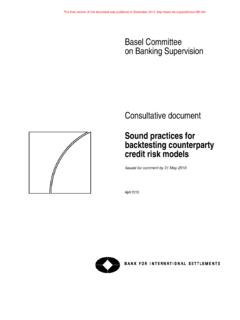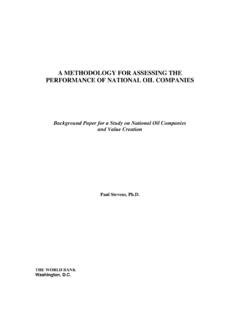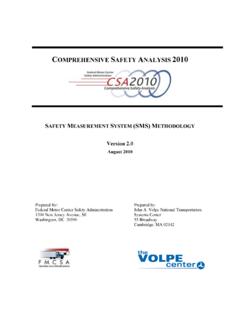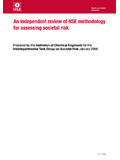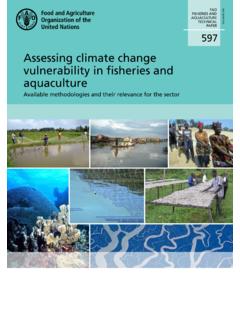Transcription of Basel Committee on Banking Supervision
1 Basel Committee on Banking Supervision global systemically important banks: updated assessment methodology and the higher loss absorbency requirement July 2013 Note: Basel III revisions published in December 2017 affect parts of this publication. This publication is available on the BIS website ( ). bank for International Settlements 2013. All rights reserved. Brief excerpts may be reproduced or translated provided the source is stated. ISBN 92-9131- 947-3 (print) ISBN 92-9197- 947-3 (online) Note: Basel III revisions published in December 2017 affect parts of this publication. systemically important banks: updated assessment methodology and the higher loss absorbency requirement iii Contents Preface .. 1 I. Introduction.
2 2 II. methodology for assessing systemic importance of 4 A. Indicator-based measurement approach .. 5 B. Sample of banks .. 8 C. Bucketing approach .. 8 D. Supervisory judgment .. 9 E. Periodic review and refinement .. 10 F. Disclosure requirements .. 11 III. The magnitude of the higher loss absorbency requirement and its impact .. 12 A. The magnitude of the higher loss absorbency requirement .. 12 B. Impact of requiring higher loss absorbency for G-SIBs .. 13 IV. Instruments to meet the higher loss absorbency requirement .. 14 V. Interaction with other elements of the Basel III framework .. 14 A. Group treatment .. 14 B. Interaction with the capital buffers and consequences of breaching the higher loss absorbency requirement .. 14 C. Interaction with Pillar 2 .. 15 VI. Phase-in arrangements.
3 15 Annex 1: Illustrative distribution of the scores of G-SIBs and their allocation to buckets .. 16 Annex 2: Empirical analysis to assess the maximum magnitude of the higher loss absorbency requirement .. 17 Annex 3: G- SIB framework operational timetable .. 20 Note: Basel III revisions published in December 2017 affect parts of this publication. systemically important banks: updated assessment methodology and the higher loss absorbency requirement 1 global systemically important banks: updated assessment methodology and the higher loss absorbency requirement Preface This document updates and replaces the November 2011 publication global systemically important banks: assessment methodology and the additional loss absorbency requirement. Below is a summary of the main changes relative to that publication.
4 These changes reflect the lessons learnt from applying the assessment methodology using data submitted by banks in respect of their positions as at the financial year-ends 2009 to 2011. The changes also include the addition of the disclosures that banks are required to make to ensure that the assessment methodology operates on the basis of publicly available information. methodology for determining the sample of banks. The methodology for determining the sample of banks used to calculate banks scores under the assessment methodology has been added and is set out in Section Indicator definitions. The following modifications have been made to the indicators used in the assessment methodology : o The Wholesale Funding Ratio, which was one of the three indicators in the interconnectedness category in the November 2011 publication, has been replaced with a Securities Outstanding indicator.
5 This change was previously highlighted in paragraphs 16 and 17 of the cover note to the November 2011 o The trading and available-for-sale indicator will exclude assets that are eligible to be classified as high-quality liquid assets (HQLA) for the purpose of the Basel III Liquidity Coverage Ratio (LCR). This change reflects the aim of the indicator to identify only those assets that may suffer a fire sale discount if sold during a period of severe market stress. Cap on the substitutability category. The application of the scoring methodology to three years of data supplied by the sample banks has revealed that the substitutability category had a greater impact on the assessment of systemic importance than was intended. Therefore, a cap will be applied to the substitutability category score (see paragraph 19).
6 Publication of template and reporting instructions. The template and reporting instructions that are being used to collect the indicator data from banks have been published. These documents provide additional clarity on the precise definitions of the 12 indicators used in the assessment methodology and the list of ancillary indicators used to inform the supervisory judgment aspects of the framework. Process for normalising banks scores changed. The November 2011 publication normalised the scores of banks in a way that resulted in a maximum possible score of 5 (the score a bank would have if it were the only bank in the sample). To make the normalisation process more intuitive, the maximum possible score is now 10,000 basis points, ie 100% (ignoring the impact of the cap on the substitutability category).
7 1 Note: Basel III revisions published in December 2017 affect parts of this publication. global systemically important banks: updated assessment methodology and the higher loss absorbency requirement Consequences of the empty bucket becoming populated. The November 2011 publication describes an empty bucket, above the four populated buckets, with a higher loss absorbency requirement of of risk-weighted assets to provide an incentive against banks further increasing their systemic importance. Paragraph 47 adds a description of the process for creating new buckets should the empty bucket become populated. Fixing the cutoff score and bucket thresholds. The timing of the publication of the cutoff score and bucket thresholds has been brought forward by one year (from November 2014 to November 2013) and will be based on end-2012 data supplied by banks.
8 The end-2012 denominators used to calculate banks scores (ie the aggregates of each of the 12 indicators across the sample of banks) will also be published in November 2013. This will allow banks to calculate their scores and see their positions within the buckets prior to higher loss absorbency requirements coming into effect based on end-2013 data. See Annex 3 for an overview of the timing of the G-SIB assessment methodology . Frequency of updating the denominators. The Committee originally intended to fix the denominators used to calculate banks scores until the completion of the first three-year review of the G-SIB methodology . The intention was to provide an absolute measure that banks could target to reduce their scores (ie the measure of their systemic impact).
9 However, the Committee found that it is not practicable to adequately neutralise the impact of exchange rate movements under a regime of fixed denominators. Furthermore, updating the denominators only after 3 years risks creating cliff effects , where banks experience large changes in their scores simply as a result of the denominator being updated. As a consequence, the Committee has decided that the denominators used to calculate banks scores will be updated on an annual basis. Disclosure requirements. Reporting guidance has been added that will require all banks with an overall size exceeding EUR 200 b illion (as measured by the Basel III leverage ratio measure of exposure), as well as bank that have been classified as a G-SIB in the previous year, to make publicly available the 12 indicators used in the assessment methodology .
10 In addition to the above, various other minor changes have been made to streamline and improve the clarity of the document. In due course the Committee will issue further guidance on the periodic review of the methodology (see paragraphs 38 and 39). I. Introduction 1. During the financial crisis that started in 2007, the failure or impairment of a number of large, globally active financial institutions sent shocks through the financial system, which, in turn, harmed the real economy. Supervisors and other relevant authorities had limited options to prevent problems affecting individual firms from spreading and thereby undermining financial stability. As a consequence, public sector intervention to restore financial stability during the crisis was conducted on a massive scale.









